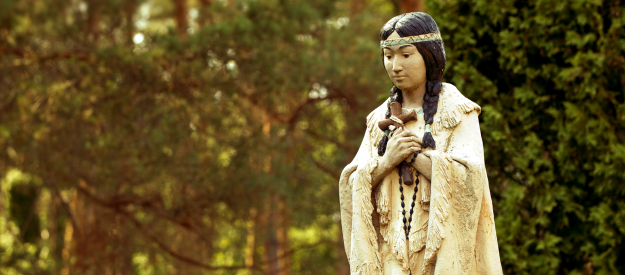Michael Higgins examines the life of a woman set to be the first native American saint
Amidst all the sturm und drang that is the current reality for American Catholics in an election year, and amidst all the prolonged upheaval created by the lingering aftershocks of the clerical sex abuse crisis, it came as a relief for the American Church to discover that they have another candidate soon to be raised to the altars: Kateri Tekakwitha.
A 17th-Century Amerindian woman, Blessed Kateri is more generally known as the ‘Lily of the Mohawks’ and has been the subject of centuries of veneration and controversy.
In some critical ways she is the creation of the Jesuits. As the religious studies professor K.I. Koppedrayer has noted: ”It was they who wrote and rewrote her biographies; they are the ones who compiled her life, modeling it on the well-known hagiography collection, Lives of the Saints.”
There is nothing surprising in this; after all, Jesuits, the Black Robes, were the most influential and coordinated of the missionary endeavours in New France, a branch of the Society of Jesus, the Bollandists, have worked to meticulously chronicle the individual lives of the saints, deleting when necessary and correcting and augmenting on occasion, and the Canadian martyrs, Jean de Brébeuf, Isaac Jogues and their companions, are permanently etched in the minds of Catholic schoolchildren throughout the continent.
Interestingly, Kateri is claimed as often for Canada as for the United States given that she lived her life prior to the creation of either country, the United States in 1776 and Canada in 1867, and moved freely across all geographical divides.
Symbol
The timing for the canonisation has been a classic case of the old process doing its work; nothing of the fast-track momentum that we have seen with Saint Josemaría Escrivá de Balaguer (founder of Opus Dei) or indeed that we are seeing now in the case of Blessed Mother Teresa of Calcutta and Blessed Pope John Paul II.
Kateri died in 1680 and from the outset the early Jesuit hagiographers were at work, recognising in her life numerous possibilities for effective evangelisation; her cause for sainthood was introduced formally in 1884; she was declared Venerable in 1943 and beatified in 1980; and all that remains now is to add her to the canon, the date of which has yet to be determined.
Her cult has flourished for centuries but it has not been without acrimony. After all, the making of a saint is more than simply the recognition of someone who is holy and worthy of invocation; it is a process fraught with all kinds of intrigue, investigations scholarly and pious, confirmed testimonials, medically certified cures, advocacy groups lobbying for ‘their’ candidate, tribal and cultural considerations, and politicking. Yes, politicking.
The Jesuits knew that they had a symbol that they could work with to show the efficacy of the Gospel, and so they become co-creators of the narrative, building the case for Kateri’s holiness.
Pious devotion plays its part but the strategic calculations involved are not inconsiderable and in the end decisive.
After all, what better way to teach than by use of the exemplum, the model to emulate, the heroic story that speaks to the imagination as well as the heart.
What the Black Robes emphasised reflected the theological priorities of the day, including the need to baptise the aboriginal peoples in the face of eternal damnation, the role of virginity and sexual asceticism in the Christian life, and the participation through one’s suffering in the passion of Jesus.
Debate
But 21st-Century America is a quite different reality. Resistance to Kateri’s progress to sainthood has stemmed from native leaders who feel appropriation of her life and legend by Christian missionaries demeans indigenous spirituality, and various feminist leaders, secular and religious, see in the elevation of Kateri to iconic status the privileging of virginity over marriage. The debate is joined.
But this should neither surprise nor disturb us. Saints are ciphers, conduits to holiness, who can be read at different times in different ways by different people.
They are universal property, a trans-border template, creators of a shared narrative. They are not flawless paragons of lifeless virtue; they are the stuff of storytelling because they lived passionately the muck and mire of human existence.
As writer Ben Okri has observed in A Way of Being Free: ”The fact of storytelling hints at a fundamental human unease, hints at human imperfection. Where there is perfection there is no story to tell.”
The saints are not perfect. That is the point. And that is why their stories should be interesting, were they not so frequently sanitised.
In fact, they can be interesting even when they don’t exist. As the Cambridge historian Eamon Duffy has noted: ”A staggering number of the figures who have evoked the most passionate veneration and the most elaborate and popular of cults have in fact been entirely fictitious, or at least no more than a name round which legend congealed.”
In the case of Kateri, we know that she existed but the meaning of her life, the nature of her holiness, her metamorphosis into what Leonard Cohen in his novel Beautiful Losers calls ”the balancing monsters of love” will be a subject for debate and exploration for some time to come. And that is a good thing. Saints percolate, realign, are made new for each generation.
Given the various ecclesial convulsions currently at play this side of the Atlantic, it is a bright spot indeed to have Catholics of many and different persuasions gather round to honour one of their own.
Michael W. Higgins is vice-president for Mission and Catholic Identity, Sacred Heart University, Fairfield, Connecticut, past president of two Canadian Catholic universities, and the author and co-author of over a dozen books.



